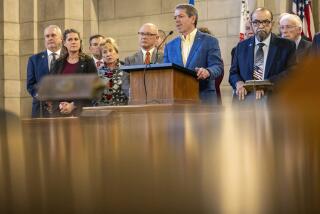Opinion: UC study: Public aid goes mainly to working families
Labor economists at UC Berkeley issued a new report Monday showing that more than half the public assistance around the country, whether it be health insurance, food aid or welfare, goes to working families.
It’s disheartening that so many Americans aren’t earning enough from work to climb their way out of poverty. The question, though, is what can be done to reduce their need for help. And the study -- which was funded by the Service Employees International Union, a union currently trying to organize fast-food workers and raise wages to at least $15 an hour -- provides no good answers on that front.
The report‘s authors looked at the cost in 2009 through 2011 of five aid programs for low-income Americans: Medicaid, the Children’s Health Insurance Program, Temporary Assistance for Needy Families (the federal block grant for county welfare benefits), the Earned Income Tax Credit and the Supplemental Nutrition Assistance Program (food stamps). It then estimated how much of that money went to families with at least one person who’d worked 10 hours or more per week for at least half the year.
According to the study, 28 million people received the earned income tax credit annually during that period, and 74% of them were in working families. That’s not surprising because the credit only goes to people who work and whose incomes are near or below the poverty line. The annual cost of providing the credit to working families: an estimated $54.2 billion.
Similarly, the study found that working families made up 61% of the Medicaid enrollment, costing federal and state taxpayers $69.2 billion annually; 36% of the food stamp enrollees, costing federal taxpayers $26.7 billion; and 32% of welfare recipients, costing federal and state taxpayers $2.8 billion.
That adds up to $152.8 billion per year nationally, $17.4 billion in California alone ($3.7 billion of which comes from the state’s coffers), by the study’s estimate.
The main work of the study is to come up with these estimates, which the authors did by analyzing administrative data from the five programs and survey data from the Bureau of Labor Statistics. But the authors also tossed in some conclusions that don’t appear to be supported by any new data or analyses.
“When jobs don’t pay enough, workers turn to public assistance in order to meet their basic needs. These programs provide vital support to millions of working families whose employers pay less than a livable wage,” the authors state. These are common-sense arguments, but by defining “working families” broadly enough to include workers who put in as little as 20 hours a month, they conflate low earnings with low wages and overstate the magnitude of the problem.
The authors also made no mention of the deep recession that caused enrollments in safety-net programs to surge, in part by forcing many laid-off people to accept part-time or lower-skilled jobs. The unemployment rate during the period under study hovered between 9% and 10%; it’s 5.5% now. And they ignored the central feature of the welfare reform that Washington undertook in the 1990s, which was to continue providing aid to parents as they made their way from the welfare rolls to payrolls.
The study concludes with the statement that “higher wages and employer-provided healthcare would lower both state and federal public assistance costs, and allow all levels of government to better target how their tax dollars are used.” That may be true, but it’s a bit like saying healthcare costs would be lower if people avoided injury and illness. The issue isn’t whether people should earn more and have better benefits, the issue is how to achieve that goal.
Higher wages are already happening as the economy improves and the job market tightens -- witness the announcements from Walmart, Target and McDonald’s, as well as the small but steady increase in average hourly earnings reported by the Bureau of Labor Statistics. And with the exception of Medicaid, which expanded significantly in 2014 as a result of the 2010 healthcare law, enrollment in public assistance programs is starting to shrink too.
The authors don’t suggest that the government hurry the process along by requiring employers to pay more -- that’s the subject of separate work by the UC Berkeley Center for Labor Research and Education -- or to provide health insurance to more workers with low earnings. So there’s no discussion of the possibility that raising the minimum wage while mandating health benefits to more part-time workers would lead to fewer jobs being created.
Some economists (including the lead author of the UC Berkeley study, Ken Jacobs) argue that a higher minimum wage will lead those who keep their jobs to spend more, stimulating the economy and creating other new jobs. But the studies that favor a moderate increase in the minimum wage don’t examine what would happen if wages were raised at the same time as health benefits were required for more workers.
We’ll get the chance to see how a very modest version of this combination works out in California over the next two years. The state raised its minimum wage to $9 an hour last July, and it will go up again to $10 in January. Meanwhile, the federal government is phasing in the requirement that companies with 50 or more employees working at least 30 hours a week offer comprehensive health benefits.
The wage increases, though, don’t go nearly as Jacobs and the SEIU have advocated in their push for a $15-an-hour wage. And the vast majority of the companies affected by the new federal insurance mandate already provide health coverage to full-time workers -- more than 90% of those with 50 to 199 employees, and 98% of those with at least 200 workers, according to the Kaiser Family Foundation. In other words, California’s experience over the next few years may not be a good predictor of what would happen if the government ordered the sort of dramatic increase in the minimum wage and expansion of health benefits that the authors of the study appear to be advocating.
That’s not to say we should do nothing. It’s not a good thing for society when so many people with jobs still require public assistance to get by. It’s just to say that the answer isn’t as simple as the authors suggest. The real solution is a better economy, but the report offers no new thoughts on how to get there.
Follow Healey’s intermittent Twitter feed: @jcahealey
More to Read
A cure for the common opinion
Get thought-provoking perspectives with our weekly newsletter.
You may occasionally receive promotional content from the Los Angeles Times.







